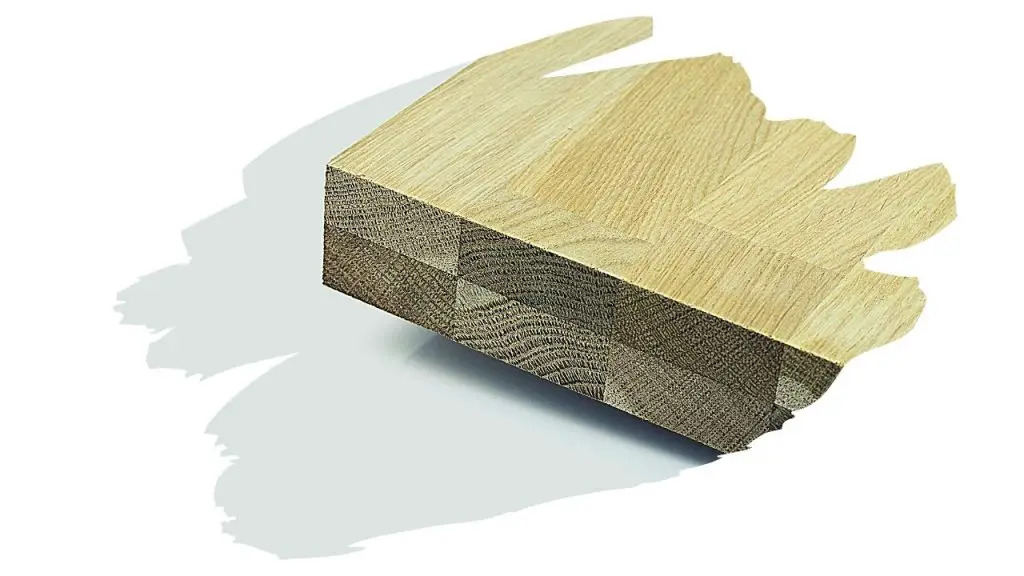Edge-glued panels allow us to easily make wide wooden projects out of regular-sized boards.
Yet, plywood panels are cheap and widely available. Plus, they already come in a handy range of wood types and sizes.
So what’s the difference between the two?
Edge Glued Panels vs Plywood:
- What is Edge Glued Board? Edge glued panels are made from gluing multiple panels of wood together along their narrow edge. As a result, the wood grain of edge glued panels all run in one single direction.
- What is Plywood? Plywood is a type of manufacture wood made by layering on ‘plies’ of thin wood one on top of another. Each ply layer is placed at right angles (45 degrees) to each previous adjoining layer. Plywoods multi-directional wood grain means its shear strength is much higher than that of edge glued panels.
What is meant by ‘Shear Strength’ when it comes to wood? To put it simply, shear strength is the term we use to measure how well a piece of wood can hold up under the pressure of a load (such as a Batten). We measure shear strength when a load runs parallel along the plane of the board.
In other words, you probably don’t want to use edge glue wood panels on projects or furniture that will need to take on high stress loads on a regular basis.
But lets take a more in-depth look at edge glued panels…

This post may contain affiliate links to products that we receive a commission for (at no additional cost to you). Learn more here.
How Strong Are Edge Glued Pine Boards?
Just because edge glued boards are less strong than plywood does not mean they are highly prone to breaking.
Typically made from Pine, edge glued panels are widely used in construction for wall paneling and doors. It is also used to make furniture such as table tops.
Now, the strength of edge glued boards comes down to three factors;
- Are The Glue Joints Gap Free?
One of the main reasons why edge glued boards fail, (especially DIY made glue joints), is due to ‘gaps’ found along the glued edge.
When you glue two boards together, you need to be sure that;
- A). You have spread the glue evenly and thickly all along the edge.
- B). You have used enough clamped pressure that there are no tiny air pockets left between the panel edges.
- How Strong Is The Wood Glue?
It is often said that, when you glue two boards together, the glue needs to be stronger than the wood itself.
What does this mean? Well it means that, when applied correctly, the glue will bond more than just the edges of the wood. It needs to be strong enough to bind the very fibers of each plane together.
Now, most modern wood glues on the market are incredibly strong.
For example, Polyurethane glue can bind more than just wood. It can glue together plastic, metal, and even stone.
Elmer’s Carpenters Exterior Wood Glue is a polyurethane adhesive that is durable, and is resistant to moisture or heat. It is possible to sand it or apply a finish onto it. And best of all it takes less than a day to fully bond.
You can check out the latest prices for Elmer’s Wood Glue over on Amazon.
- How Strong Is The Wood Type Used?
Pine is popularly used for making these types of wood panels, and it is a strong and durable softwood.
Spruce is also commonly used as a material for edge-glued boards. It is stronger than Pine, and is surprisingly durable for such a light-weight wood.
Can You Cut Edge Glued Panels?
Yes, you can cut through this type of wood board just like you can cut through plywood or any other lumber.
But, you need to be sure that you’ve given the edge-joints time to properly bind and dry. After which, you can cut your panel down to size however you wish.
Can Plywood Be Edge Glued?
Plywood can be edge glued, but it is going to be difficult to manually line up each ply panel perfectly.
You are going to need to use a biscuit joiner to create biscuit slots that will allow you to line up the two plywood boards.
Using a biscuit joiner, create 2 or 3 slots alongside the to-be-glued edges of both plywood boards. And try and avoid making the biscuit slots near the very ends of the board.
What is a biscuit joiner? Also known as a Plate Joiner, this power tool allows you to join boards along their edge or face grain. It does this by cutting small crescent shaped slots into the side of two opposing edges of board. These slots are just big enough for a wooden ‘biscuit’ to slide into. Before we slot the biscuit into place – and attach the two boards – we coat it with wood glue. And as the glue dries, it fastens the biscuit into place – holding the two board-edges together neatly.
Final Thoughts
So, if you’ve ever wondered what the difference is between edge glued panels and plywood, the answer is simple:
Edge glued boards are wood panels that are joined side-by-side along their narrow edge. Plywood is made from wood boards that are layered one on top of the other (at alternating right angles).
Both of them are used to make furniture, building materials, and the like. Although plywood is that little bit stronger thanks to all of its cross-grain layering.



